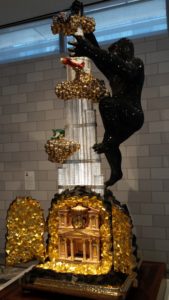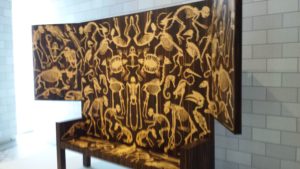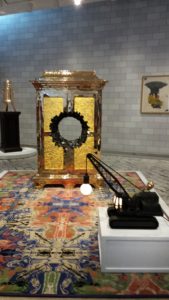We took our teen daughter to the Museum of Arts and Design recently, curious to check out a smaller Manhattan museum we hadn’t yet been to. I highly recommend taking the free docent tour, which lasts about an hour and gives a good highlight of the exhibits. Of course you can head back to look further before or after you’re done.
It’s not a big museum, so if you’re looking for something manageable with the kids (an hour or less), this is a good option. It’s in Columbus Circle and it’s free for kids 18 and under ($16/adult). They have a number of family programs as well, so check that out when planning your visit.

The museum hosts several exhibits at a time and doesn’t not have a permanent exhibit, our guide said. Right now, the big exhibit is Studio Job Mad House, which reminded me a bit of the Jeff Koons exhibit I saw at the Whitney. Studio Job goes through August 21.
[ad name=”Google Adsense-1″]
The design team behind Studio Job is Belgian Job Smeets and Dutch Nynke Tynagel – their studio is in Antwerp. They design the work, and have artisans make it. Their pieces are all functional, even if that functionality is minimal.

This is their first U.S. solo exhibition, and it looked like it was staged in a castle. The designers used faux wood flooring and faux brick walls. The Burj Khalifa (above) is designed to look like the famous image of King Kong climbing the Empire State Building. Only in this case, it highlights the power of the Middle East, changing through time (see clock at bottom). Also part of the Middle East (and time changes) is Petra at the bottom in gold. King Kong is covered in 110,000 Swarovski crystals.

Throughout the exhibition, we saw examples of the designers putting themselves into the art, as in this stained glass piece. I didn’t ask what part of them is in the lamp below, titled “sex cake.”

If you look up close, you can see reliefs of a heterosexual couple in various in-action poses (reminiscent of some of the erotic vases and depictions seen in other museum pieces from thousands of years ago). My daughter pointed out some sperm designs as well. This is easily a piece you could steer your kids away from if you felt it was inappropriate for them.

I really liked these banana lamps, which again are functional, but don’t actually provide that much light. Studio Job’s work has been labeled kitch by some, for good reason (much like Jeff Koons’ work).

This monkey night light was a fun piece, and while there were LED lights inside, I actually couldn’t see much light coming out. The chest is guarded by a monkey, or maybe the monkey is stealing the goods inside – we had a discussion about that. The gold is 24 carat, and inside is a secret treasure (you can peek in). The monkey is covered in Swarvoski crystals too.

We had a big discussion on the Big Ben piece above, which has a lot going on. It was built before Brexit, though one can certainly come up with a lot of symbolism from that. The two-story bus on top is exploding after the 2005 terrorism attack. Big Ben is perched on top of an unstable coal-looking material, resting on top of Parliament. The artists don’t explain their work, but leave them open to interpretation.

While we didn’t talk about the Eiffel Tower, this is the piece I’d choose to put in my house. I really liked it and it’s more functional as well!

We saw a number of examples of Studio Job tables, including this one of the Tah Mahal. Of course it being upside down and black (instead of white) invites discussion.


The workmanship in this inlaid wood stool was stunning. This was a commissioned piece, and it’s quite large. Not only are the lighter colored wood pieces cut out, but the background wood is as well, so they can fit in there perfectly, like a puzzle.

We didn’t come up with a good explanation for this functional chest which is gilded. And we didn’t talk about the construction lamp which I could so easily see in a little boy’s bedroom. The chest has interesting designs stamped in the gold as well.

This horse vacuum was strange. Not pictured is the long vacuum stick. Occasionally the vacuum turns on and the eyes light up, which I caught in the picture. Yes, the vacuum is functional.

The most stunning piece in the exhibition (in my opinion) was this cross chest titled Chartres. The front, pictured above, is a gold gilded cross with scenes that look like they could be from the Gates of Hell. While we didn’t see it open, there’s a picture (below) of what it looks like. It’s a big piece, and the pictures don’t do it justice.

When you walk around the side, you see a model of the French cathedral Chartres on its side. We talked about how the gold doors, if placed on the floor so the cathedral was righted, perhaps would be the gates of hell. Not sure where the artist was going with all this, but the piece was stunning.

We saw another interesting inlaid wood piece, a wardrobe, that was commissioned by a Dutch family. They wanted a family portrait, and the designers suggested doing it on a wardrobe.


The piece looks like it’s painted, so when you get up close and see the inlaid wood, it’s quite surprising. The guide wasn’t able to tell me how much they paid for this.
I’ll just do a quick overview of the other exhibits we saw. The first was Eye for Design which featured graphic design created by the museum in the 1960s-70s. This exhibit runs through September 18.

The final exhibit was of Harry Bertoia, who was a metal forger. The exhibit showed some of his early metal work and mongraphs, and the well-known diamond-backed chairs he designed (below) – he sold the patent to Knoll for $20,000.


The interesting part of this exhibit for me was the Atmosphere for Enjoyment section, where we saw his sonombients. These are metal rods of similar size and shape placed together in a holder. When you move them they make sounds by hitting against each other. Bertoia made around 400 LPs with music from them, and if you come to the museum at specific times, you can hear musicians doing a concert on them. They allow visitors to go up one at a time to make some noise, which we did. It’s fun!

The museum’s fifth floor has artist studios. They host a number of guest artists who come one day a week for several months. You can watch them work and talk with them. We were there on a Saturday and learned about Mallory Weston‘s work. She makes large jewelry pieces that are from small pieces of metal sewn onto fabric. You can see her snakeskin designs above. Using a drill press, she hand-cuts tiny diamonds of different metals, punches three holes in each tiny diamond, and sews them onto fabric. You can see some of her pieces and the tiny metal diamond shapes, on her website.

Where: Museum of Art and Design (MOAD) is at 2 Columbus Circle in Manhattan.
When: Guided tours are daily at 11:30 and 3. Get info on MOAD hours here.

